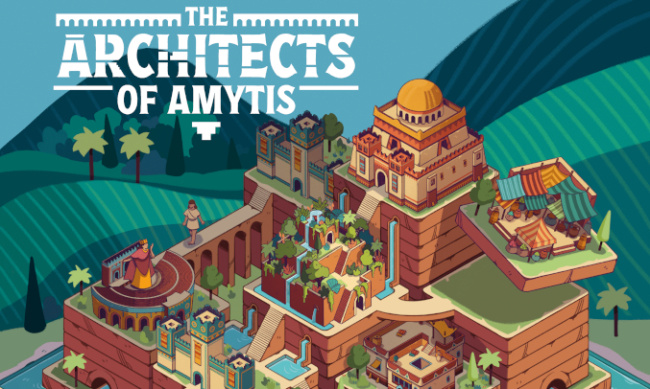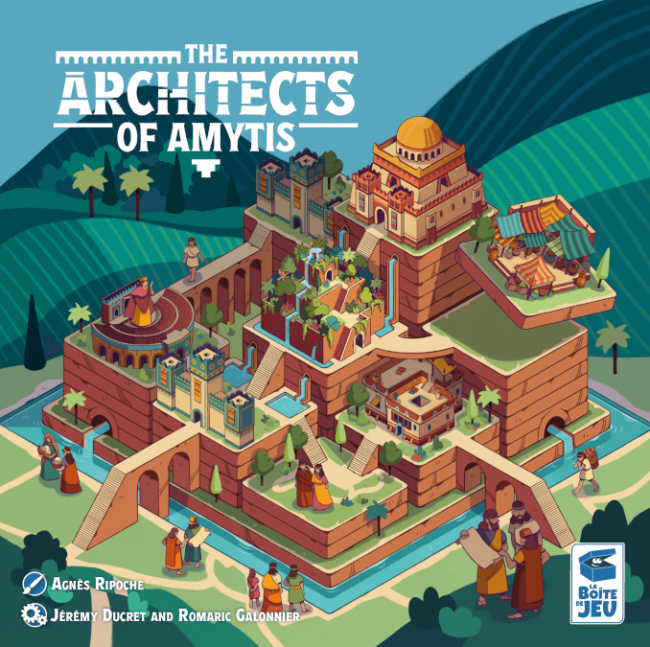The Architects of Amytis
Publisher: La Boite de Jeu/distributed by Hachette Boardgames USA
Release Date: April 2025
MSRP: $29.99
Creator(s): Jeremy Ducret and Romaric Galonnier (Designers); Agnes Ripoche (Artist)
Format: Boxed Board Game
Number of Players: 2
Playing Time: 30 mins.
Age Rating: 10 and up
ICv2 Rating: 3 Stars out of 5
The components of the game are good, and reasonably attractive. The basis of the game is sort of worker-placement, in that you are placing your architects on a shared board to acquire tiles, one at a time. Each player then places these acquired tiles on their own board, to create desired patterns and combinations to maximize scoring. This is slightly complicated by the various ways in which the players score points. So, it is a worker placement/tile placement/pattern matching game… sort of.
There are six types of tiles in any game, each with its own ways of scoring points. In addition, though, there are King's Favours, which can give the player bonus points both for creating specific patterns or stacks of tiles, as well as for having multiple Favours by the end of the game.
Then there are Project cards, of which each player starts with two and can earn more. These give point bonuses for making your display of tiles match the arrangements of tile colors on the Project tile. This is where an unfortunate rules error crept into either the text or its translation, because the players specifically cannot score from a mirror image of a scoring pattern, but they can score from any rotated position of the Project tile… some of which are identical to a mirror image of the tile. Based on very limited information in the short rulebook, it looks like rotations take priority, but it may only because the designers didn’t think through how geometry works.
The mechanics of this game are deceptively simple, because the playing time assumes that both players are playing it as a light game. Each player will typically have 15-20 turns in the game. The difficulty is that it is very easy to spend a lot of time thinking about any given turn, and the play of the game can easily stretch out as a result. To add another level of complexity, the placing of Architects is almost a sub-game of a Tic-Tac-Toe variant: if you place three Architects in a row, you get a Favour. You also get your Architects back on a slightly faster schedule, which is sometimes an advantage, but the real trick is obtaining Favours that will give you the most points for how you hope to lay out your tiles, which are arranged and stacked on your own 3x3 grid.
Getting four favors or more will often give a player more points just for having the Favours than could be earned by actually filling the pattern that the Favour wants you to make. This kind of logic makes the scoring tricky to predict, especially since some of the scoring doesn't happen until the end of the game. Since the color of the tile can matter, as well as how many tiles are in a stack, as well as its position relative to other tiles of the same type out of six, it is difficult to estimate scoring at a glance. In fact, players will have to double-check their final scores the first few times they play.
This is not a bad game, but may be a misleading one. In many ways it is more of a design puzzle than a light game. It should find an audience, and its low price will make it attractive, but it may be a frustrating game for players who want a game that is as light as its suggested age range and time would suggest.

ICv2 Stars: 3 (out of 5)
Posted by Nick Smith on May 16, 2025 @ 3:37 am CT
MORE GAMES
'A Villainous Halloween' In-Store Event
August 15, 2025
Wizards of the Coast announced A Villainous Halloween , a new Magic: The Gathering Commander in-store WPN event.
Base Game, Expansions, Accessories
August 15, 2025
Asmodee will release The Witcher: Path of Destiny core game, expansions, and accessory pack.
MORE REVIEWS
ICv2 Stars: 3.5 (out of 5)
July 30, 2025
Here is a review of Ravensburger's Horrified: Dungeons & Dragons.
ICv2 Stars: 3.5 (out of 5)
July 24, 2025
Check out the review of Disney Villainous: Treacherous Tides, from Ravensburger.








